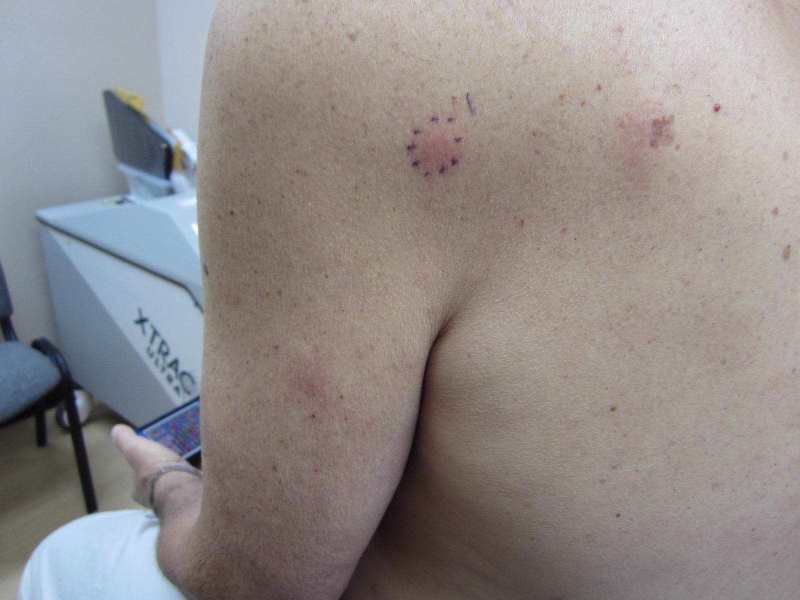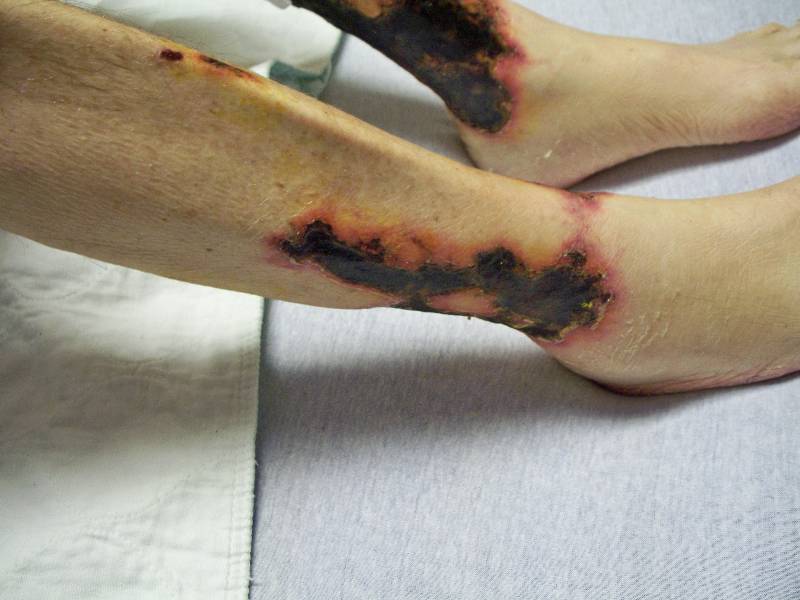CORRECT DIAGNOSIS:
Cutaneous Extramedullary Hematopoiesis
DISCUSSION:
Extramedullary hematopoiesis (EMH) usually stems from chronic myeloproliferative disorders in adults and intrauterine hematologic disorders or rubella, coxsackie, herpes, and CMV infections in children. It usually presents in the liver or spleen (1, 2). The cutaneous form of EMH represents a seldomly seen presentation of an already rare disorder with an estimated prevalence of 0.4% of total EMH cases (3).
The exact etiology and pathogenesis of this condition remain unclear. Some have demonstrated high titers of transforming growth factor (TGF)-B1 in EMH while others have shown an increase in JAK2 V617F mutations in patients with myelofibrosis and EMH, causing speculation of a possible pathogenic role (2, 4). Whatever may be the triggering factor, a bone marrow barrier becomes disrupted which results in seeding and metastatic migration of abnormal hemopoietic stem cells (5, 6).
On exam, patients can present with red to purple macules, papules, plaques, or nodules. These are more commonly found on the head and neck regions of younger patients and on the torso in adults. Patients may complain of pain, pruritus or they may be completely asymptomatic (1, 5). Histological findings include focal areas of myeloid/erythroid precursor cells and megakaryocytes. Some authors note that a diagnosis does not require all three findings to be present (7). There has also a case involving eosinophilic precursor infiltrations as well (8).
According to current literature, EMH presenting outside of the hepatosplenic region, but not necessarily in the skin, carries a poor prognosis of median survival of 13 months (9).
TREATMENT:
Efficacious treatment options towards symptomatic cutaneous EMH have included low-dose radiation, electron beam therapy, and treating the underlying neoplastic process (5, 9).
REFERENCES:
1. Acenero MJF, Borbujo J, Villanueva C, Penalver J. Extramedullary hematopoiesis in an adult. JAAD, May 2003;48(5).
2. Kawakami T, Kimura S, Kato M, Mizoguchi M, Soma Y. Transforming growth factor-B overexpression in cutaneous extramedullary hematopoiesis of a patient with myelodysplastic syndrome associated with myelofibrosis. JAAD, April 2008;58(4).
3. Hocking WG, Lazar GS, Lipsett JA, Busuttil RW. Cutaneous extramedullary hematopoiesis following splenectomy for idiopathic myelofibrosis. Am J Med. 1984;76:956-8.
4. Fraga GR, Caughron SK. Cutaneous myelofibrosis with JAK2 V617F mutation: metastasis, not merely extramedullary hematopoiesis! Am J Dermatopath. 2010 Oct;32(7):727-30.
5. Haniffa MA, Wilkins BS, Blasdale C, Simpson NB. Cutaneous extramedullary hemopoiesis in chronic myeloproliferative and myelodysplastic disorders. JAAD, August 2006
6. Patel BM, Su WPD, Perniciaro C, Gerts MA. Cutaneous extramedullary hematopoiesis. JAAD, May 1995;32(5).
7. Revenga, F. Cutaneous extramedullary hematopoiesis. International Journal of Dermatology, Dec 2000;39(12).
8. Kwon KS, Lee JB, Jang HS, Chung TA, Oh CK. A case of cutaneous extramedullary hematopoiesis in myelofibrosis with a preponderance of eosinophilic precursor cells. J Dermatol. 1999;26:379-84.
9. Koch CA, Li CY, Mesa RA, Tefferi A. Nonhepatosplenic extramedullary hematopoiesis: associated diseases, pathology, clinical course, and treatment. Mayo Clin Proc 78. 1223-1233; abstract




